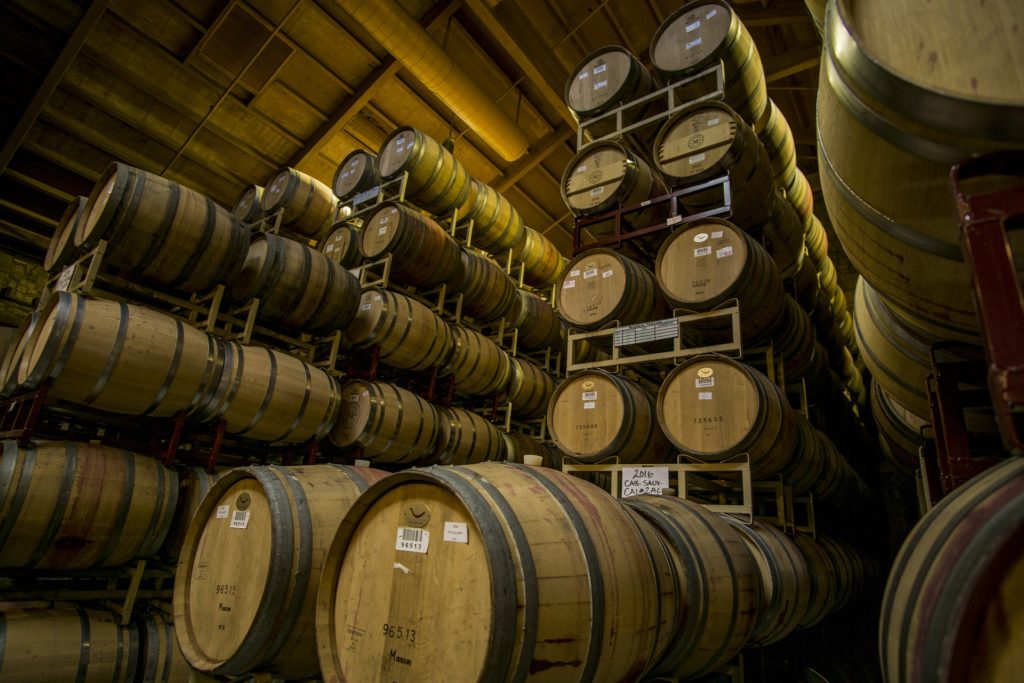The flavor of wine is greatly affected by the winemaker’s touch. Essentially, the taste of wine is not only determined by the regional differences but also the winemaking process. There are several things done in the cellar to improve the flavor of wine. One of these techniques is aging wine in oak. There are many more techniques which you can learn by visiting your local winery. Knowing these terms allows you to understand the winemaker’s intentions and how to predict the style of wine before tasting it.
There are three parts of wine aging or storage:
- Letting the wine brew on its own
- Chemically and sensually monitoring the wine’s process
- Conducting a series of rackings needed for clarification
The three elements make a complete system by working together to keep the wine safe as it matures. The winemaker needs to maintain the SO2 levels, ensuring the temperature stays at 55-60°F, and monitoring its evolution by tasting every 4-6 weeks. This is undertaken throughout the wine production.
Here is a guide showing the types of aging vessels and reasons for each procedure.
Aging In Bottles
In this wine aging procedure, wine ages after bottling. The aging process is also called reduction aging since wine ages without oxygen. To enhance the flavor, the bottle is completely sealed making it airtight which stops oxidation of the wine. Failure to check early during the aging process leads to alterations in the wine tasting experience. Eventually, the process changes rapidly, making the experience either good or bad depending on the type of wine.
The aging result is unpredictable, and winemakers hardly use it as a primary method of aging. After purchasing a bottle aged wine, ask the winemaker the extra time needed to bottle age it further or consume it right away.
Aging in Oak Barrels
Oak barrels are commonly used nowadays to age wine. Oxidation takes place slowly in oak barrels, giving the distinctive wine aromas in the wine aging stage. However, these kinds of traditional winemaking techniques have several disadvantages including the slow aging process along with time wastage. To add to it, unwanted microorganisms such as Brettanomyces and Dekkera may attack the barrels, containing them. Therefore, barrels must be renewed regularly to reduce this risk.
To prevent this, wineries are researching on alternative technologies of wine aging that take little time and preserve wine after the aging process. One of these winemaking techniques is the use of physical and micro-oxidation of wine. Each method produces different results after the wine aging process. Other methods of wine aging include electric fields, ultrasonic waves, and gamma irradiation. Studies proved that wine aged using these techniques took little time along with offering high-quality wines.
French Oak
The wood used in oak aging is from Europe. French oak is used as a winemaking tool to make the silky wine smooth. French oak makes it easy to transfer flavors evenly. Additionally, enhancing flavors leads to an increase in tannin content and intense aromas.
American Oak
For big and robust red wines, winemakers use the American oak. This wood introduces big flavors such as coconut and vanilla, and it will, therefore, need big wines to match the characteristics. Compared to the French oak, American oak is more porous, allowing oxygen to dissolve faster. The wine also matures soon, and high tannin wines don’t need long aging. American oak requires grapes that don’t soak up wine flavors easily, or it will subdue the wine.
Aging in Concrete Vats
Contrary to what many people think, concrete aging is not a new concept. This is due to the increased experimental use. Initially, concrete has a limitation in the oxidation process since it’s not so porous. This made the development of complex flavors hard. However, concrete vats serve the purpose of preserving the flavor effectively. It is an appropriate option for maintaining aromas and flavors, perfect for aging white wine.
Aging in Stainless Steel
Stainless steel is an excellent preserver and doesn’t affect flavor, essence, or the overall wine experience directly. The stainless steel wine aging option is perfect for those who want to preserve the natural flavor of the wine. Moreover, stainless steel is much easier to clean compared to concrete vats. It is also durable making it favorable for large scale production.
Better Wines in Old Vines
Vines take a long time to grow (100+ years), but they start producing grapes after two years. At twenty, the yield begins to reduce but the quality of grapes increases. In the wine world, the lower the return means higher the quality. It is very logic; older vines produce grapes with a high concentration of flavor, while young vines will provide a high yield with a low concentration of flavor. Search for “Old Vine” or “Vieilles Vignes” in French on the label for high-quality wine. Don’t worry about the price; some of them are not that expensive.
Geographical habitat of Wines
To simply put it, the terroir is a significant determinant of wine flavor acquired from a particular region. Climatic conditions also influence it. An example is vineyards producing Châteauneuf-du-Pape grapes, which have soils littered with pebbles. The pebbles provide minerals that contribute to the wine taste. The vine roots dig into the ground after years of growing, absorbing the minerals. This aspect varies around the world, therefore, to establish the exact taste of wine focus on the terroir of the vine and its geographical attributes.
Concluding remarks
Modern winemaking techniques have contributed a lot in improving the quality of wine. This doesn’t dispute the old methods as they were also useful. New wine aging techniques make the aging process fast, thereby increasing wine production. You need both the art and science of making wine and to find out what works with a grape varietal truly, you need to experiment with different wine tasting options. Cheers to your next pop up!
